Ecology of the Rocky Mountains

The ecology of the Rocky Mountains is diverse due to the effects of a variety of environmental factors. The
These habitats are home to a great deal of wildlife from herbivores, such as
Permanent human settlement of the Rocky Mountains has caused numerous species to decline in population, including species of trout, birds, and sheep.

Setting

The Rocky Mountains range in latitude between the Liard River in British Columbia (at 59° N) and the Rio Grande in New Mexico (at 35° N), and in height up to the highest peak, Mount Elbert at 14,440 feet (4,400 m), taking in great valleys such as the Rocky Mountain Trench and San Luis Valley. Precipitation ranges from 10 inches (250 mm) per year in the southern valleys[2] to 60 inches (1,500 mm) per year locally in the northern peaks.[3] Average January temperatures can range from 20 °F (−7 °C) in Prince George, British Columbia to 43 °F (6 °C) in Trinidad, Colorado.[4]
Biotic zones
Ecologists divide the Rocky Mountain into a number of
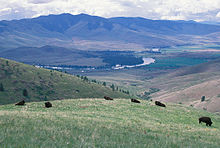
The
Biotic zones and vegetation types in the Rocky Mountains can be explained by
Extensive investigations have been made of the forests of the Rocky Mountains.[6] Weber cautioned that the vegetation zones "overlap and telescope into each other considerably" in a landscape that is "always full of surprises."[9] The resulting patchwork mosaic of vegetation types and disturbance regimes leads to a complex of side-by-side communities, wildlife habitats, and species distributions.[1]
Plains
The eastern side of the Rocky Mountains is bordered by
Riparian and canyon forests
Broad-leaved deciduous cottonwoods,
Pinyon-juniper woodland
In the southern Rocky Mountains, a transition occurs between about 5,900 and 8,200 feet (1,800 and 2,500 m), where plains communities are accompanied by
Ponderosa pine woodland
The appearance of

In geological time, ponderosa pine ecosystems are relatively new to the foothills of the central Rocky Mountains. An even newer addition to the ecosystem, European-American settlers, devastated the ponderosa pine forests through logging for houses, fencing, firewood, mine timbers, and railroad ties, and with fire. The ponderosa pine forests were close to the developing population centers at the forest-prairie edge. The scale of the loss of ponderosa pine habitat is demonstrated best in several hundred paired photographs from the early 20th century and 1980s. However, nearly all the paired photographs also reveal that the most important feature of the ponderosa pine ecosystem is its resilience. Ponderosa pine seedlings establish quickly in disturbed sites. Research in the Front Range of Colorado shows a tenfold increase in ponderosa pine biomass since 1890 in many stands. This regeneration has restored habitat for many wildlife species[1] but has also led to unnatural forest densities in many areas.[12]
Pine-oak woodland
In the southern Rocky Mountains, lower slopes of ponderosa pine communities can be accompanied by
Douglas-fir forest
Douglas-firs grow in a broad range from Mexico to British Columbia, generally from near lower treeline upward in elevation to spruce-fir forests. In Colorado, the species ranges from about 5,410 to 8,860 feet (1,650 to 2,700 m) and is often found in mixed stands with ponderosa pine,
Cascadian forest
Several tree species commonly associated with the Cascade Mountains grow on the rain-swept western slopes of the northern Rocky Mountains. These include
Montane seral forest
Lodgepole pine forests interspersed with stands of
Intervals between fires typically range from 100 to 300 years. As evidenced by the fires in the Yellowstone National Park in 1988, lodgepole pine forests are rejuvenated by crown fires that replace tree stands. Aspen stands are keystone communities for hundreds of birds and mammals and are especially important forage for deer and elk.[1]
Spruce-fir forest

The
Subalpine white pine forest

On exposed, dry slopes at high elevations, subalpine white pine forests replace spruce-fir forests. Common species of the white pine forests include
Treeline vegetation
Alpine tundra
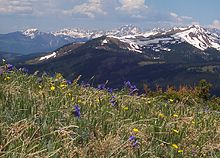
Fauna
The Rocky Mountains are important habitat for a great deal of wildlife, such as
European-American settlement of the mountains has adversely impacted native species. Examples of some species that are known to have declined include
Invertebrates
Although most of the animals in the Rocky Mountains are invertebrates, little is known about this component of the region's fauna. As one entomologist[
Amphibians

Globally, populations of amphibians are declining in size as a result of
Fish
The Rocky Mountains are home to a number of coldwater fish in the trout and salmon families, including rainbow trout, bull trout, lake trout, cutthroat trout, brown trout, brook trout, golden trout, mountain whitefish, Arctic grayling, and Dolly Varden.[18] Many of these, however, are introduced, such as rainbow, brown, and brook trout.
Colorado River cutthroat trout
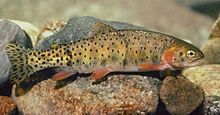
Colorado River cutthroat trout were once abundant in mountainous tributaries of the Green and Colorado rivers, but non-native brown, brook, and rainbow trout had displaced them by the 1930s. They still survived in some isolated pockets, however, and these populations have been used to restore the cutthroats to many areas in their historic range. One of the largest strongholds was, and is, Trappers Lake in Colorado's Flat Top Mountains. However, in 1984, brook trout invaded because a flood washed them downstream from nearby Crescent Lake. By 2003, brook trout comprised 40 percent of the lake's fish population. Brook trout have an advantage over cutthroat trout because they spawn in fall. By the time Colorado River cutthroats hatch in August, brook trout fingerlings may be able to eat them. Colorado Parks and Wildlife is controlling their population with large nets and selective removal.[19]
Rio Grande cutthroat trout
Rio Grande cutthroat trout currently live on 700 miles of stream in the Santa Fe National Forest, which is approximately 91% of their historical range. The Rio Grande cutthroat trout was a candidate for listing under the Endangered Species Act from 2008 to 2014. In 2014 it was removed from candidacy as it was determined that listing was not warranted for this species.[20][21] Rio Grande cutthroat have the distinction of being the southernmost subspecies of cutthroat trout. However, due to the loss of populations across their native range and reports of Rio Grande cutthroat in Mexico and Texas, it is unclear how far south this trout once occurred. In 1955, it was designated the state fish of New Mexico.
Greenback cutthroat trout

The
Yellowstone cutthroat trout

Mountain whitefish

Mountain whitefish, unlike cutthroat trout, have not declined significantly in their native range.
White sturgeon
The largest freshwater fish in the Rocky Mountains (and North America) is also in trouble. The
Birds
The Rocky Mountains are home to over 300 species of birds. These include raptor species that migrate through the mountains, such as
Bald eagles

The coniferous and deciduous forests of North America have long been the home of bald eagles. Bald eagle populations are now recovering after years of hunting, habitat destruction, and pesticide-induced deaths. In the early 1970s, Colorado had just one breeding pair of bald eagles but by 1993 biologists counted 19 breeding pairs. In Wyoming nesting attempts increased from 20 in 1978 to 42 in 1988. The bald eagle has not yet fully recovered, however; pesticide residues continue to inhibit bald eagle reproduction, and
Peregrine falcons
White-tailed ptarmigans

White-tailed ptarmigans have been monitored in Rocky Mountain National Park, Colorado, since 1966. Short-term population cycles are well documented in populations that are not hunted but not in populations outside the park, which are hunted. Although detailed population size data are available from more than 28 years of monitoring, scant information is available on habitat change, predator populations, or other potential causes of change in ptarmigan populations. In the park, the population seems to be increasing. A 2-year study revealed lower ptarmigan densities where elk use was greater, although characteristics of willow, which is ptarmigan habitat, did not significantly differ in the high- and low-use elk sites. Furthermore, a 2-year study of ptarmigan habitat cannot explain 28-year trends in population size. Habitat loss and other factors partly responsible for ptarmigan deaths—such as predation and competition—were not studied during the 28-year period.[1]
Ducks and geese

Many species of
Trumpeter swans
Neotropical migrant songbirds
Many forest-dwelling songbirds breed in the Rocky Mountains and winter in Central and South America. Wildlife biologists suspect that population size declines in the songbirds may be partly the result of increased predation and brood parasitism. Brood parasitism by brown-headed cowbirds, for example, increases as a result of nearby logging. In conifer forests in west-central Idaho, common songbirds benefited from timber harvest, whereas the abundances declined of rare species that inhabit old-growth forests (hermit thrush, Swainson's thrush, and pileated woodpecker).[1]
Mammals
Black bears
Grizzly bears

Grizzly bears once roamed throughout the Rocky Mountains and the western Great Plains. They were hunted relentlessly by European settlers in the 19th century and early 20th century. The last known grizzly bear in Colorado was killed in 1979. The decline of the bears to just 2% of their original range tells of the human-caused extirpation of large predators in the Rocky Mountain region. Only 700-900 grizzly bears may be alive today in the conterminous United States, with 300 grizzlies alive in the Canadian Rockies.[29] During the last 20 years, about 88% of all grizzly bears studied in the northern Rocky Mountains were killed by humans.[1] The U.S. Fish and Wildlife Service is considering delisting the grizzly in Montana, Idaho, and Wyoming.[30]
Cougars
Gray wolves

Wolves once were common throughout the Rocky Mountains. They were shot, poisoned, and trapped into local extinction by early settlers and federal agents. The last Gray wolf in Colorado was killed in 1940, and the wolf was first listed as an endangered species in 1967. Wolves from southeastern British Columbia recolonized northwestern Montana in 1986; by 1994 the population had grown to 7 packs and about 70-75 wolves. Wolves from Glacier National Park have dispersed naturally as far away as northeastern Idaho and just south of Yellowstone National Park. A wolf was shot near Yellowstone National Park in 1992. From January to March 1995, 15 adult wolves from 7 different packs in Canada were introduced into central Idaho wilderness areas. Several pairs have bred and produced the first litters of wolf pups born in Idaho in more than 50 years. Fourteen wolves (three family groups) were released in the Yellowstone National Park in late March 1995.[1] A total of 66 wolves were released to the two areas in this manner in January 1995 and January 1996.[32] Several wolves from the Northern Rockies have dispersed to the Southern Rockies but have failed to establish a population there. Most have been killed.[33]
2013 estimates of wolf populations in the two recovery zones reflect the success the species has had in both areas:
- Greater Yellowstone Area: 460
- Central Idaho: 684
These numbers, added with the estimated number of wolves in northwestern Montana (500), puts the total number of wolves in the Northern U.S. Rocky Mountain recovery area at over 1500 individuals. This includes approximately 134 packs (two or more wolves traveling together) and 71 breeding pairs (male and female that successfully rear a litter of at least two until Dec. 31). The recovery goal for the area was 30 breeding pairs total, and this number has been surpassed for some time.[34] In addition, there are at least 120 grey wolves in the Canadian Rockies.[35]
The restoration of the gray wolf to the Yellowstone National Park not only restores an important ecosystem component (the wolf) and process (predation by wolves) to bring the park into better ecological balance, but it also is economically sound. After weighing the costs (including full reimbursement to ranchers for the loss of livestock) and benefits (increased revenues from hunting and tourism), economists estimated (before the actual restoration took place) a net $18 million return during the first year after the wolves were returned, and about $110 million in 20 years. More tourists are expected to visit the area of the Yellowstone National Park and to stay longer in hope of hearing or seeing wolves in the wild.[36] Compensatory payments to ranchers for the loss of cattle and sheep to wolves averaged about $1,800 per year in northwestern Montana.[1]
Mustelids

Many types of mustelids inhabit the meadows, forests, and peaks of the Rocky Mountains. Types of weasels here include:
- Wolverine (Gulo gulo)
- American badger (Taxidea taxus)
- Northern river otter(Lontra canadensis)
- Pacific marten (Martes caurina)
- Fisher (Pekania pennanti)
- Long-tailed weasel (Neogale frenata)
- American mink (Neogale vison)
- Black-footed ferret (Mustela nigripes)
- American ermine (Mustela richardsonii)
Mustelids are some of the most important predators of squirrels, mice, and voles, although wolverines can take down an animal as large as a caribou and the primary food of river otters is fish. Several species, including the river otter, black-footed ferret, and wolverine, have declined over much of their range because of
Cervidae
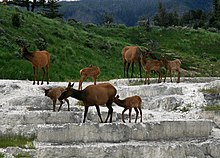
Members of the deer family (
.Population trends in North American elk and deer (mule deer and white-tailed deer combined) may be heading in opposite directions. The number of elk has increased steadily in Colorado and Wyoming, whereas the abundances of deer are showing signs of decline. Elk on
Woodland caribou were historically found in most of the northern Rocky Mountains, possibly ranging as far south as Wyoming. They have declined dramatically over most of their range and have been eliminated in the Lower 48. Currently, populations are found in the Canadian Rockies, Alaska, and several other ranges. The primary cause for their decline is the logging of old-growth forests. British Columbia is attempting to reverse their decline by culling the province's abundant wolves.
Moose populations have increased 50% since 1980 in Wyoming and have been rapidly increasing since the reintroduction into Colorado beginning in 1978 and 1979.[1] Colorado currently has a thriving population of approximately 2,500 moose.[38] However, in Yellowstone National Park, moose have declined from 1,000 animals in the 1970s to 200 in 1996.[39]
Pronghorn
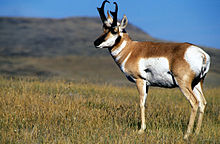
Many areas of the Rocky Mountains, notably Yellowstone and Grand Teton national parks, have significant populations of pronghorn. Many of these are migratory. Grand Teton's population migrates all the way from the Green River Basin each year, through many developed areas. Efforts have been made to preserve its migration route.
Bighorn sheep
Populations of
Bison
In the 1800s,
Beaver

Squirrels
Many types of squirrel inhabit the forests of the Rocky Mountains, including several species of chipmunks such as the Uinta chipmunk and the least chipmunk. Overwinter chipmunk survival rates are less than a third.[43] Tree squirrels include the American red squirrel (also known as pine squirrel), and the Abert's squirrel, found only in ponderosa pine forests. There are also several types of ground squirrels, such as the Wyoming ground squirrel, the rock squirrel, and the golden-mantled ground squirrel.[44][45] Squirrels are important to the forest because they help spread the seeds of many plants. They are also a major food source for predators like martens, weasels, and hawks.[1]
References
- ^ a b c d e f g h i j k l m n o p q r s t u v w x y z aa ab ac ad ae af ag ah ai aj ak al am
 This article incorporates public domain material from T.J. Stohlgren. Rocky Mountains. United States Geological Survey. Archived from the original on September 27, 2006. (verbatim source).
This article incorporates public domain material from T.J. Stohlgren. Rocky Mountains. United States Geological Survey. Archived from the original on September 27, 2006. (verbatim source).
- ^ "Southern Rocky Mountains". Forest Encyclopedia Network. Retrieved August 22, 2010.
- ^ "Northern Rocky Mountains". Forest Encyclopedia Network. Archived from the original on July 21, 2011. Retrieved August 22, 2010.
- ^ a b Sheridan, Scott. "US & Canada: Rocky Mountains (Chapter 14)" (PDF). Geography of the United States and Canada course notes. Kent State University. Archived from the original (PDF) on September 1, 2006.
- .
- ^ a b c d e
Peet, R. K. (1988). "Forests of the Rocky Mountains". In Barbour, M. G.; Billings, W. D. (eds.). North American terrestrial vegetation. New York: Cambridge University Press. pp. 63–101. ISBN 978-0-521-55986-7.
- ^ ISBN 978-0-521-55986-7.
- ^ ISBN 978-0-521-55986-7.
- ISBN 978-0-87081-041-1.
- ^ Mullen, LD; et al. (1992). Biological Diversity. U.S. Department of Agriculture, Forest Service, Rocky Mountain Region. p. 9.
- JSTOR 1940259.
- ^ Covington, W. Wallace; Fule, Peter Z.; Moore, Margaret M.; Hart, Stephen C.; Kolb, Thomas E.; Mast, Joy N.; Sackett, Stephen S.; Wagner, Michael R. "Restoring Ecosystem Health in Ponderosa Pine Forests of the Southwest" (PDF). U.S. Forest Service.
- ^ a b c d e f Cameron, Ward (2005). "Life Zones of The Rocky Mountains". MountainNature.com. Archived from the original on October 29, 2005. Retrieved October 22, 2010.
- ^ "USFS Colorado spruce beetle map" (PDF). Rocky Mountain National Park. National Park Service.
- ^ Keane, Robert E. (1999). McCool, Stephen F.; Cole, David N.; Borrie, William T.; O'Loughlin, Jennifer (eds.). The importance of wilderness to whitebark pine research and management. Wilderness science in a time of change conference. Wilderness as a place for scientific inquiry. Vol. 3. Missoula, Montana: U.S. Department of Agriculture, Forest Service, Rocky Mountain Research Station. pp. 84–92. Proceedings RMRS-P-15-VOL-3.
- ^ Petit, Charles (January 30, 2007). "Science Section". New York Times.
- ^ Powell, J. A (1995). "Lepidoptera inventories in North America". In LaRoe, E. T.; Farris, G. S.; Puckett, C. E.; Doran, P. D.; Mac, M. J. (eds.). Our living resources: a report to the nation on the distribution, abundance, and health of U.S. plants, animals, and ecosystems. Washington, D.C.: U.S. Department of the Interior, National Biological Service. pp. 168–170.
- ^ Hempstead, Andrew. "Fish". Canadian Rockies. Moon Travel Guides. Archived from the original on August 17, 2012. Retrieved August 13, 2012.
- ^ Mitton, Jeff. "The quiet struggle between brook and cutthroat trout". Colorado College of Arts and Sciences. University of Colorado.
- ^ "Species Profile Rio Grande Cutthroat Trout". U.S. Fish and Wildlife Service. Retrieved July 10, 2014.
- ^ New Mexico Game and Fish http://www.wildlife.state.nm.us/rio-grande-cutthroat-trout-no-longer-an-endangered-species-candidate/
- ^ "Greenback Cutthroat Trout". Colorado Parks and Wildlife.
- ^ Kenworthy, Tom (October 2, 1994). "Discovery of Alien Trout leaves Officials at Yellowstone reeling". Washington Post.
- ^ a b "Lake Trout". Yellowstone National Park. National Park Service.
- ^ "Whirling Disease". Yellowstone National Park. National Park Service.
- ^ "Mountain Whitefish". Yellowstone National Park. National Park Service.
- ^ Hempstead, Andrew. "Birds". Canadian Rockies. Moon Travel Guides. Archived from the original on August 17, 2012. Retrieved August 13, 2012.
- ^ a b "Colorado Parks and Wildlife". Colorado Parks and Wildlife. Archived from the original on December 7, 2016. Retrieved December 29, 2016.
- ^ a b Hempstead, Andrew. "Bears". Canadian Rockies. Moon Travel Guides. Archived from the original on August 17, 2012. Retrieved August 13, 2012.
- ^ "Grizzly Bears & the Endangered Species Act". Yellowstone National Park. National Park Service.
- ^ Chadwick, Douglas. "Ghost Cats". National Geographic. Archived from the original on November 20, 2013.
- ^ "Wolf Restoration". Yellowstone National Park. National Park Service.
- ^ Fixler, Kevin (July 24, 2016). "Colorado wolf advocates, wildlife managers again feud over reintroduction". Summit Daily.
- ^ "Rocky Mountain Wolf Recovery 2005 Interagency Annual Report" (PDF). USFWS. Archived from the original (PDF) on May 24, 2006. Retrieved May 3, 2006.
- ^ Hempstead, Andrew. "Wild Dogs and Cats". Canadian Rockies. Moon Travel Guides. Archived from the original on August 17, 2012. Retrieved August 13, 2012.
- ^ French, Brett (September 27, 2021). "Montana wolf hunt criticized by Yellowstone Park superintendent". Billings Gazette. Retrieved September 28, 2021.
- ^ "Deer eating away at forests nationwide". NBC News. January 18, 2005.
- ^ Wickstrom, Terry (August 13, 2016). "Moose populations are thriving in Colorado". Denver Post.
- ^ "Moose". Yellowstone National Park. National Park Service.
- ^ Goldfarb, Ben (March 24, 2015). "Bison to be Reintroduced in Banff". High Country News.
- ^ "Bison Ecology". Yellowstone National Park. National Park Service.
- ^ "Beavers". Yellowstone National Park. National Park Service.
- JSTOR 3672112.
- ^ "Squirrels and Chipmunks". Rocky Mountain National Park. National Park Service.
- ^ "Rock Squirrel - Spermophilus variegatus". Nature Works.
Further reading
- Constantz, George. Ice, Fire, and Nutcrackers: A Rocky Mountain Ecology. Salt Lake City: University of Utah Press, 2014. ISBN 978-1-60781-362-0
